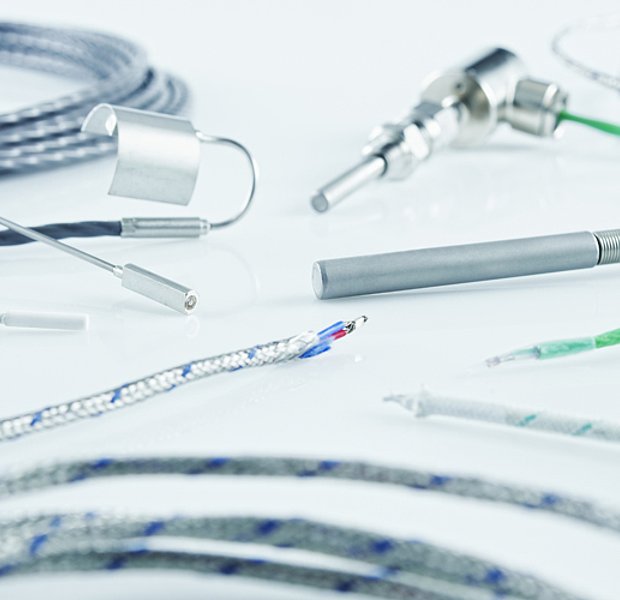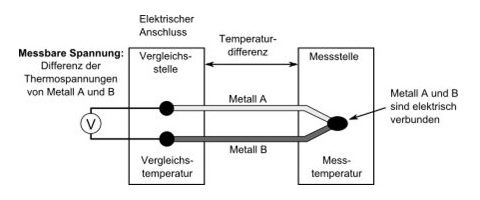
Thermocouples
As active sensors, thermocouples are used widely in measuring and control technology. They measure the temperature across the very large temperature range of -200°C to +1700°C. They are used in plant construction, mechanical engineering and apparatus engineering, as well as for temperature determination in molten salt and metal. Thermocouples are a low-cost alternative to pyrometers in many high temperature applications.
Technical information on thermocouples
General
Thermocouples consist of two different electric conductors, usually metals, connected together to form a circuit. There are therefore two transition points from one material to the other, the measuring point and the comparison point. If the temperatures at the two transition points are different, an electrical voltage is formed between the two materials. This is the result of a thermoelectric effect (Seebeck effect).
Use
Most thermocouples are used in molten metal, in exhaust gases from smelting furnaces, or in factory chimneys. Highly flexible and robust, sheathed thermocouples are used in almost every sector, from laboratory operations to the automotive industry.
In order to achieve consistently high measuring accuracy over long periods, the thermocouples must be selected carefully for their purpose. Two selection criteria – the maximum temperature and the measuring medium used – are crucial to achieving the measuring task successfully.
An NiCr-Ni thermocouple (type K), for example, is highly resistant to oxidising media. However, heating over 850°C changes its thermoelectric properties to such an extent that lasting measuring deviations occur at low temperatures (<100°C).
The Fe-CuNi thermocouple (type J and L) is highly vulnerable to oxidation from +550°C, but has good resistance to reducing media. The limit temperature is approx. +700°C. The same goes for Cu-CuNi thermocouples, although these are only suitable for temperatures in the range +400°C ... +600°C.
Thermocouples containing platinum (type S, R and B) are suitable for high-temperature use with temperatures up to +1700°C. All platinum-rhodium-platinum thermocouples are sensitive to gases containing sulphur or phosphorus.
A general problem for unprotected thermocouples is the fact that foreign substances and metal vapours can diffuse in at temperatures above +1000°C, resulting in changes to the thermoelectric properties of the thermocouple.
For these reasons, suitable measures such as installation in gas-tight ceramic or metallic protective pipes or protective sheaths must be taken, depending on the atmosphere, temperature range and thermocouple.
Operating principle
There are essentially two different types of thermocouple.
Type 1: In the classic thermocouples, the thermoelectric wires are usually insulated with ceramic tubes or glass fibre and then slid into a suitable protective pipe. In contrast to resistance thermometers, no heat-conducting paste is used, as thermocouples are usually operated at temperatures above 1000°C. The protective valves consist of ceramic or heatproof steel; a light metal connection head of form A is usually used.
Type 2: Sheathed thermocouples are fully constructed thermo lines that have a stainless steel pipe as their outer sheath. The thermoelectric wires inside are embedded in metal oxide ceramic and thus insulated from one another and from the sheath. Sheathed thermocouples are bendable at outer diameters of 0.5 to 6 mm. There is usually a cable transition sleeve with a firmly connected compensation line directly after the element, or a plug connection is directly mounted.
The thermoelectric or Seebeck effect is the occurrence of a thermoelectric voltage due to a temperature gradient along an electrical conductor. Described by the Boltzmann transport equation, it is a volume effect rather than a contact effect. This means that a difference of potential (a voltage) can form even in a single electrical conductor if the temperatures at the two ends are different.
The following consideration on momentum conservation demonstrates this: The individual impulses p of the free load carriers in an electrical conductor are greater at the warm end of the conductor than at the cold. To ensure that the resulting impulse is the same at both ends, there need to be more “cold” than “warm” load carriers. This results in a load shift: an electrical difference of potential, a voltage. The effect depends on the material. Different metals thus have different thermoelectric voltages, which are described in characteristic curves. The best-known thermocouples, and those most commonly used in industrial temperature measuring technology, are types K, J and S.
The connection point of a thermocouple is given the function of the measuring point; the transition to the (copper) wires leading to the voltage measuring device is given the function of the comparison point. Using thermo lines or compensation lines, the comparison point can be shifted to a location further away, e.g. to the control room in industrial plants. These thermo lines consist of identical thermo materials; the compensation lines are made from lower-cost materials that have the same thermoelectric properties as the thermocouple in a limited temperature range.
As a thermocouple can only be used to determine a temperature difference between the measuring point (hot junction) and comparison point (cold junction), cold junction compensation (CJC) is needed to measuring the temperature.
